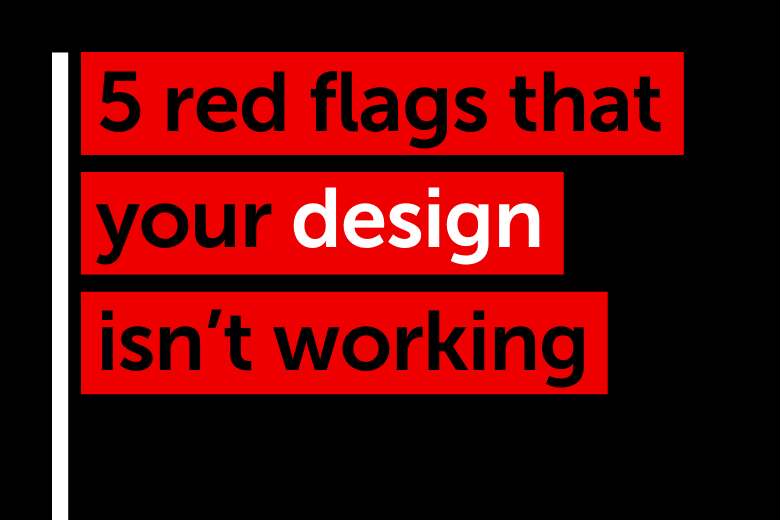Design
5 Red Flags that your design isn’t working
If everyone is a designer, then is anyone?
It’s tempting to think that anyone can turn their hand to design — after all it’s never been easier, quicker, or less expensive to produce something that looks acceptable, and that’s exactly what a lot of brands do.
That doesn’t mean that everyone is a designer.
If your content looks ‘alright’, you might be happy enough to publish it, but that doesn’t mean it’s supporting your strategy, your brand, or your business growth. Here are five red flags that tell you your design isn’t doing its job.
1. It’s using an obvious template
With the accessibility of programmes like Canva, design templates are widely available and very popular, quick, and convenient. They’re also uncreative and easy to spot. Generic layouts achieve little to nothing for your brand — yours is one of many,it’s unmemorable,and it doesn’t communicate anything about your business, except perhaps that it’s uninspiring.
Speaking of fading into the background ….
2. It has no identity
The whole point of abrand is to evoke your values and qualities whenever customers and prospects see, read, or hear anything from you. If your design lacks identity, it can’t represent anything, and if it can’t represent anything, then it can’t support your brand.
Your design should be unmistakably yours —someone should be able to recognise your work without seeing your name or logo. That doesn’t mean everything should look the same, but that your design should have a style of its own — when you see a Picasso, you know it’s a Picasso, and when people see your design, they should know it’s yours.
A style or a visual ‘feel’ is incredibly difficult to communicate, but a brand style guide can express it for you. A style guide defines the elements that represent your brand — typography, colour palettes, logo usage rules, and even your mission statement, purpose, and company principles. They will all give a designer vital and useful direction.
You’ll also set your design up for success by including a profile or a persona of your buyer.
3. It’s not designed with the prospect in mind
A lot of businesses produce content that looks great, that they’re delighted with, and from a design point of view is excellent, but that just doesn’t work.
That’s probably because they made it for themselves, not for their prospects.
A design can be visually and creatively brilliant, and you might absolutely love it, but it will fall completely flat if it’s not appropriate for your audience. ‘2001: A Space Odyssey’ is a masterpiece, but you wouldn’t pop the kids in front of it on a rainy Saturday afternoon.
When you’re thinking about design, think about your targets — what kind of people are they? How does their industry operate? What are they used to seeing? Will they respond better to something that meets their expectations, or that stands out from the crowd? What will they see that will make them think ‘this is for me’?
4. It’s over-designed
In a lot of design work, there’s far too much going on. It could be because it’s accommodating too many requests and requirements, it could be because of an attempt to communicate too much at once: either way, the result is a very busy and unappealing logo, webpage, or sales pdf.
A quote that’s sometimes attributed to Mark Twain, and sometimes Blaise Pascal, is, ‘I apologise for such a long letter — I didn't have time to write a short one’.Counterintuitively, simplicity is more difficult and takes longer than complexity. Design that does one thing well is more time-consuming than design that does many things badly, but the former is what will get you results.
5. You didn’t use a designer
The ultimate red flag for a piece of design is that it was prepared by someone without a design background. That’s not to say an ‘amateur’ can’t do good work, or that every single piece of visual output needs a specialist, but as a rule of thumb, you’re far less likely to encounter the issues in this article if you givethe design work to a designer.
As with design templates, technology can give the impression that design is something anyone can do if they simply have the tools. That’s far from true — you couldn’t hand anyone a chisel and expect Michelangelo’s David.
Originality, identity, purpose, and simplicity are all things that a designer will be trained and practised in, have an eye for, and keep at the forefront of their mind when working on a brief, and if you want to nail your brand identity, properly connect with your customers, and grow your business, you need Nutcracker’s design team.
If you need to develop or evolve your brand, give your packaging the impact it needs, bring your research and data to life, or just make someone stop scrolling and engage with your content, call us on 020 3941 0305 or message hello@nutcrackeragency.com.
Share this:




![It takes a lot of effort to get prospects’ attention, so once you do, this is how you make sure you keep it.]](https://cdn.sanity.io/images/gkbnlmj8/production/1dfc77cf559813c3990d61c477f74905d99107c7-1200x680.png?rect=1,0,1199,680&w=700&h=397&auto=format)